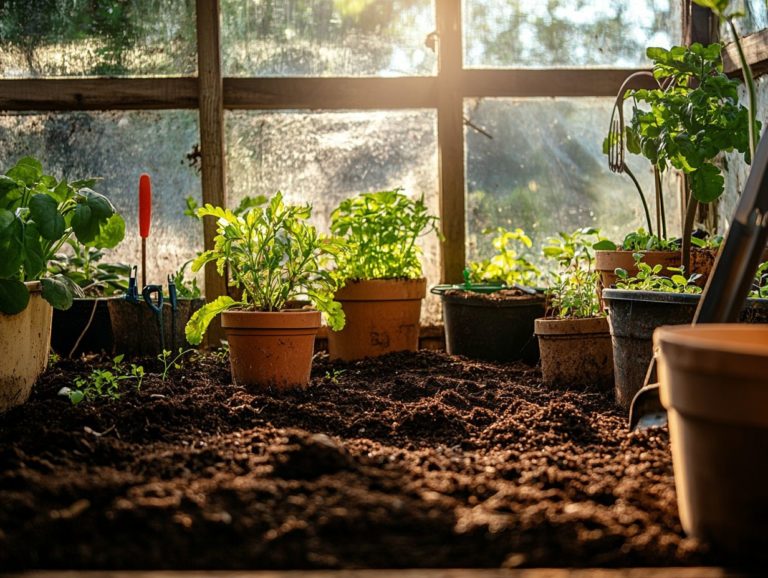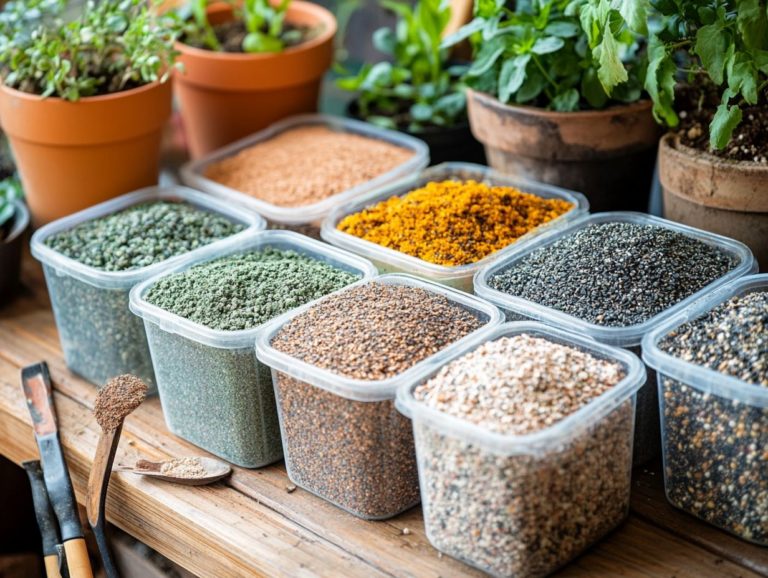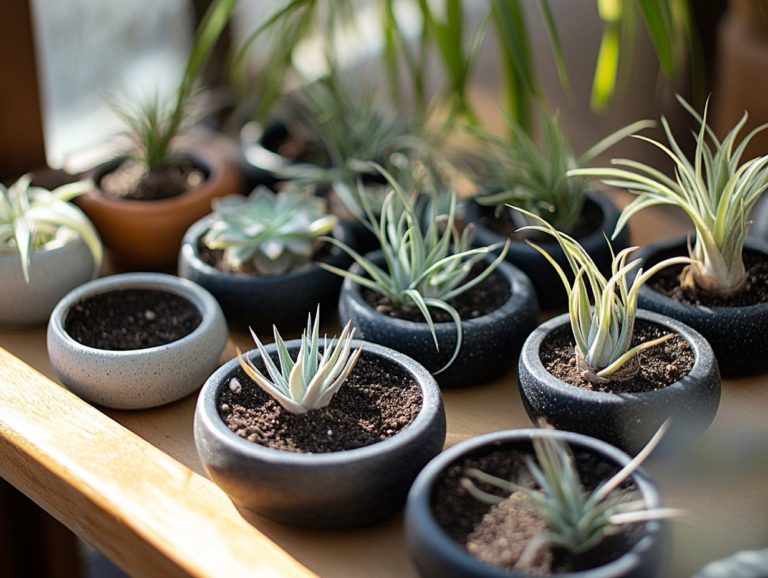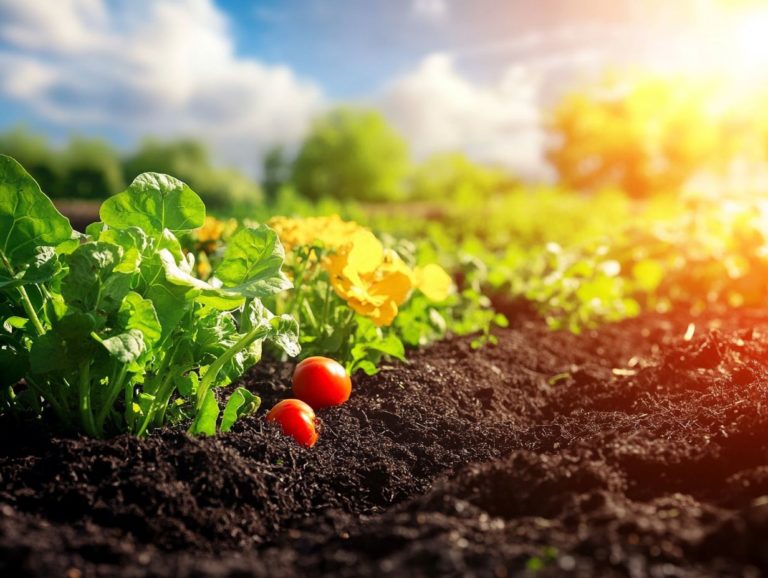How to Choose Fertilizers for Different Plants
Don t wait! Understanding your plants nutrient needs is key to a thriving garden.
Let s dive into the vital nutrients your plants crave for strong, healthy growth. This article highlights the essential nutrients required for optimal growth, explains the differences between organic and inorganic fertilizers, and guides you in selecting the right type based on your soil composition and your plants’ specific growth stages.
You ll learn how to interpret fertilizer labels, explore various application methods, and discover tips to enhance effectiveness while avoiding over-fertilization. Prepare to elevate your gardening journey!
Contents
- Key Takeaways:
- Understanding Plant Nutrient Needs
- Types of Fertilizers
- Factors to Consider when Choosing Fertilizers
- How to Read Fertilizer Labels
- Application Methods for Fertilizers
- Tips for Using Fertilizers Effectively
- Frequently Asked Questions
- What should I consider when choosing fertilizers for my plants?
- How do I determine the type of fertilizer my plants need?
- What are the different types of fertilizers available for different plants?
- How often should I fertilize different plants?
- Can I use the same fertilizer for all of my plants?
- Are there any natural alternatives to chemical fertilizers for different plants?
Key Takeaways:

- Choose fertilizers based on the essential nutrients that your plants need for healthy growth.
- Consider factors like soil composition, plant type, and growth stage when selecting fertilizers for optimal results.
- Read and understand fertilizer labels, paying attention to the N-P-K ratio, which refers to nitrogen, phosphorus, and potassium, the three essential nutrients critical for plant health. Apply fertilizers correctly to avoid over-fertilization.
Understanding Plant Nutrient Needs
Understanding the nutrient needs of plants is crucial for maintaining soil quality and fostering healthy growth in a diverse range of crops, from leafy greens to fruit-bearing varieties. Key nutrients like nitrogen, phosphorus, and potassium are essential in fulfilling the macronutrient requirements of plants.
By recognizing the signs of nutrient deficiencies, you can make informed decisions about fertilizer applications, enhancing nutrient uptake and promoting overall plant health.
Essential Nutrients for Plant Growth
Essential nutrients like nitrogen, phosphorus, and potassium are vital for your plants’ health, significantly influencing soil quality and nutrient cycles.
These nutrients play key roles in various physiological processes, including photosynthesis, energy transfer, and root development. For example, nitrogen is crucial for protein synthesis and often comes from organic matter and legumes, enriching the soil. Phosphorus facilitates both root and flower development and typically sources from mineral deposits or animal manures.
Potassium helps regulate your plants metabolism and water usage, boosting their resistance to diseases and environmental stress. By ensuring balanced fertilization, you provide your plants with the right amounts of these essential nutrients, promoting optimal growth and fostering sustainability within your ecosystems.
Types of Fertilizers
Understanding the different types of fertilizers is essential for effective crop management. Fertilizers fall into two main types: organic, like compost and animal waste, and inorganic, which are chemical products.
This knowledge enables you to make informed decisions that enhance your agricultural practices.
Organic vs. Inorganic Fertilizers
Organic fertilizers, like compost tea, provide a nutrient-rich haven for your plants, contrasting with inorganic fertilizers. While the latter delivers nutrients quickly, they can threaten sustainable farming practices.
By choosing organic options, you improve soil structure and biodiversity, nurturing beneficial microbial activity. Overusing inorganic fertilizers can lead to nutrient leaching and soil degradation. Embracing organic materials boosts your crop yields over time and fosters environmental health.
While synthetic fertilizers may provide quick results, they can compromise your soil s long-term fertility. It’s crucial to consider the different impacts on both soil quality and productivity, striving for a balanced approach that secures lasting agricultural success.
Slow-release vs. Quick-release Fertilizers

Choosing between slow-release and quick-release fertilizers can have a big effect on your plants’ growth. Slow-release fertilizers are your best bet for reducing the risk of nitrogen burn while promoting balanced fertilization over time.
Quick-release fertilizers provide an immediate nutrient boost, perfect for when your plants need a rapid growth spurt or show signs of nutrient deficiency. However, this quick fix comes with risks, such as leaching or nutrient runoff if applied too liberally, which can negatively affect both your plants and the environment.
Timing your applications is key. Slow-release options allow for less frequent applications, reducing labor and ensuring a steady nutrient supply. This makes them particularly advantageous for long-term garden planning. Quick-release fertilizers, while great for immediate needs, require careful monitoring to avoid over-fertilization.
Factors to Consider when Choosing Fertilizers
When selecting fertilizers, you should think about a few things, such as soil composition, pH, and crop type. Make sure to evaluate carefully for the best results!
Soil Composition and pH
Soil composition and pH are vital factors that shape nutrient availability and influence the growth and health of your plants.
Well-aerated soil with the right pH helps plants absorb nutrients better. The delicate balance of sand, silt, and clay affects both its structure and its ability to hold essential nutrients like nitrogen, phosphorus, and potassium.
Conversely, poor soil quality can lead to nutrient leaching, where valuable fertilizers are swept away by rain or irrigation, significantly reducing their benefits.
Understanding how soil composition affects fertilizer use can drastically improve your crop yields and foster a healthier ecosystem.
Plant Type and Growth Stage
Different plant types and their growth stages have specific nutrient needs, influencing how you should apply fertilizer for optimal development.
For example, leafy greens usually flourish with higher nitrogen levels during their early vegetative phase, helping them develop that lush foliage you admire. Conversely, flowering plants require a balanced blend of phosphorus and potassium as they move into their reproductive stage, ensuring they produce abundant blooms and set fruit effectively. To enhance your indoor gardening experience, check out this guide on how to select the best indoor plant fertilizer.
As your plants mature, their nutrient uptake will evolve, meaning you’ll need to adjust your fertilization schedules and types accordingly. Grasping these nuances not only boosts your plants’ health but also makes your resource use more efficient.
How to Read Fertilizer Labels
Understanding the intricacies of fertilizer labels, especially the N-P-K ratio and associated numbers, is vital for cultivating a nutrient-rich environment that caters to the needs of your crops.
This ratio shows the levels of nitrogen (N), phosphorus (P), and potassium (K) in the fertilizer. With this knowledge, you can craft a tailored approach that enhances growth and optimizes yield.
Understanding N-P-K Ratio

The N-P-K ratio on fertilizer labels reveals the relative amounts of nitrogen, phosphorus, and potassium. These nutrients are essential for understanding a fertilizer s nutrient profile.
Understanding this ratio is vital whether you’re a gardener nurturing a backyard oasis or a farmer cultivating vast fields. Each nutrient plays a distinct role in promoting plant health and growth. For example, nitrogen is crucial for leaf development and overall vegetative growth. Higher N ratios are particularly beneficial for leafy vegetables like spinach and lettuce.
Phosphorus supports root development and flowering. Therefore, a balanced ratio is usually recommended for fruiting plants such as tomatoes, which often thrive with higher P content. Meanwhile, potassium enhances overall plant vigor and resilience against stress, making a 5-10-10 ratio particularly effective for root crops. To learn more about the different options available, check out our guide on types of fertilizers.
Maintaining the proper nutrient balance ensures that fertilizers are used efficiently. This optimizes plant performance while reducing any negative environmental impact.
Application Methods for Fertilizers
Selecting the appropriate application methods for fertilizers whether through top-dressing, leaf spray, or root application is key to getting nutrients to your plants quickly and effectively! This ensures they receive essential nutrients during those pivotal growth stages, enhancing their health and vitality.
Top-dressing, Leaf Spray, and Root Application
Top-dressing and root application are powerful fertilizer techniques that can enhance your plants’ nutrient uptake and promote healthy growth. When you apply these methods correctly, you can significantly boost nutrient availability during crucial growth phases.
Top-dressing is especially beneficial during the active growing season, as it ensures that nutrients are easily accessible to the root zone. This fosters robust growth and resilience. Leaf sprays provide a quick way for essential nutrients to reach your plants, allowing them to absorb them directly through their leaves. This method is ideal when you notice signs of stress.
Root application is typically used early in the planting cycle, ensuring that nutrients penetrate the soil effectively. This optimizes their availability for developing roots. Grasping the timing and best practices for each of these methods is vital for maximizing their impact on your plants’ vitality.
Tips for Using Fertilizers Effectively
To optimize plant health and enhance crop yields, it is crucial to follow a fertilizing schedule that prioritizes both timing and dosage. This careful approach fosters robust growth while safeguarding against over-fertilization. Over-fertilization can harm soil quality and contribute to environmental pollution.
Proper Timing and Dosage
Proper timing and dosage of fertilizers are essential for maximizing nutrient absorption and achieving optimal growth in your plants.
To determine the ideal moments for applying fertilizers, observe the specific growth stages of the plants you re nurturing. During the early stages, when seedlings develop their root systems, a balanced application can enhance nutrient uptake without overwhelming them.
As your plants mature, their nutrient needs will evolve. Understanding these varying requirements throughout their lifecycle enables you to tailor your applications effectively. By implementing a schedule that considers factors like weather conditions, soil tests, and plant type, you can significantly improve nutrient absorption. This ensures your plants thrive and develop robustly.
Start your fertilizing journey today for vibrant, healthy plants!
Preventing Over-fertilization
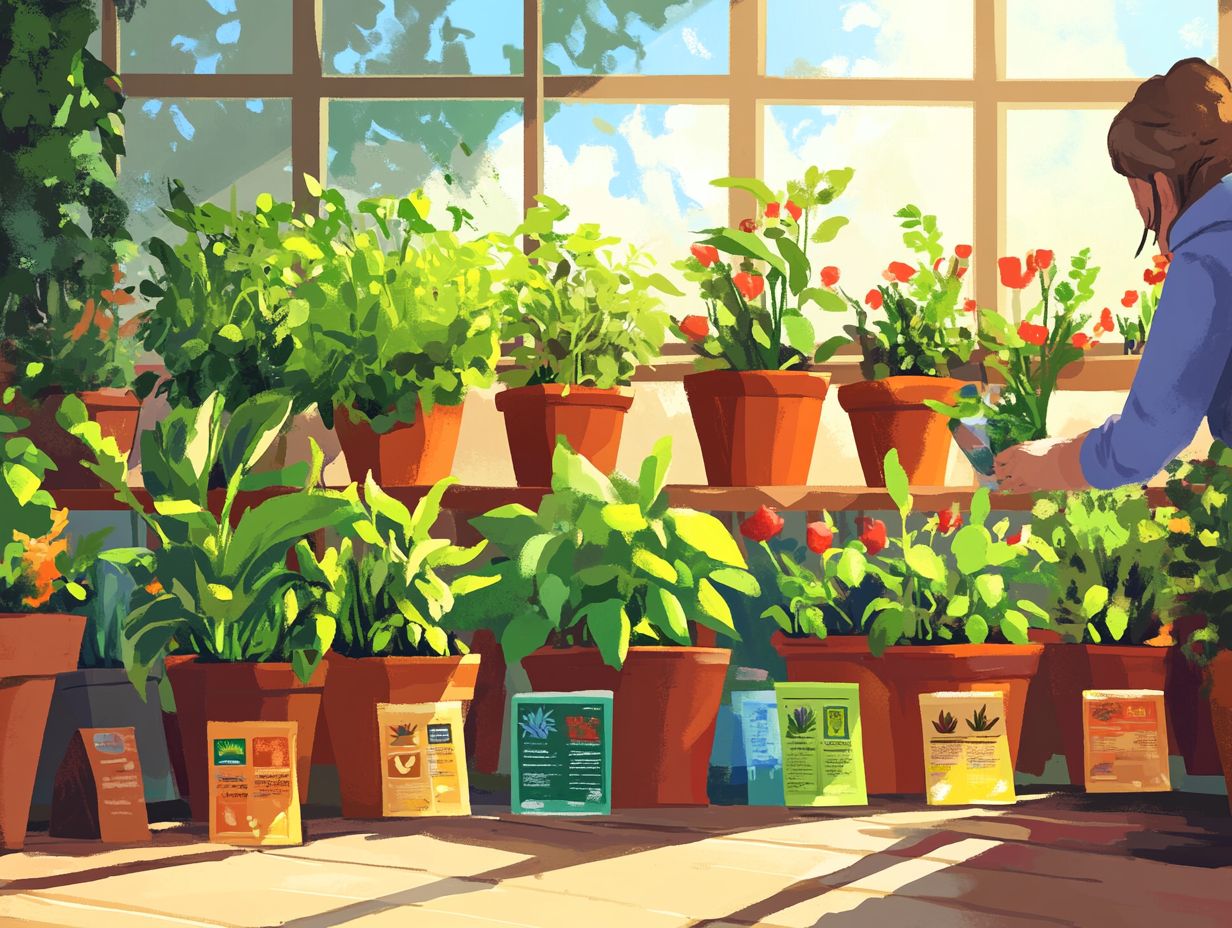
Preventing over-fertilization is essential. It keeps your soil healthy and protects the environment from pollution.
Applying too much fertilizer disrupts the mix of nutrients in the soil. This can harm your crops and lead to runoff that contaminates water sources, causing environmental challenges like algae blooms.
To reduce these risks, consider adopting the following strategies:
- Conduct soil tests: Accurately determine nutrient needs.
- Implement crop rotation: This naturally enhances soil fertility by alternating crops.
- Use slow-release fertilizers: These minimize leaching and provide nutrients over time.
By prioritizing these approaches, you can safeguard your soil’s health while fostering a healthier environment!
Frequently Asked Questions
What should I consider when choosing fertilizers for my plants?
When choosing fertilizers, consider the plant type, growth stage, nutrient needs, and soil conditions. Different plants require specific fertilizers and have varying nutrient needs at different growth stages.
How do I determine the type of fertilizer my plants need?
Conduct a soil test or research your plants’ nutrient requirements. Consulting with a gardening expert or reading fertilizer labels can also help you choose the best type for your plants.
What are the different types of fertilizers available for different plants?
There are three main types of fertilizers: organic, synthetic, and granular. Organic fertilizers come from natural sources and are often slow-release, while synthetic fertilizers are chemically produced and act faster. Granular fertilizers are typically a mix and come in a slow-release form.
How often should I fertilize different plants?
The frequency of fertilization varies based on the plant type, growth stage, and fertilizer used. Generally, most plants should be fertilized once a month during their active growing season. Always follow the instructions on the fertilizer label for specific guidelines.
Can I use the same fertilizer for all of my plants?
No, using the same fertilizer for all plants is not recommended. Different plants have unique nutrient needs, and using the incorrect type can harm them. It s best to choose fertilizers specifically formulated for your plants’ types and needs.
Are there any natural alternatives to chemical fertilizers for different plants?
Yes! Many natural alternatives exist, such as compost, manure, and worm castings. These organic options provide essential nutrients and improve soil health. Using natural fertilizers also reduces the risk of over-fertilization and benefits the environment.

